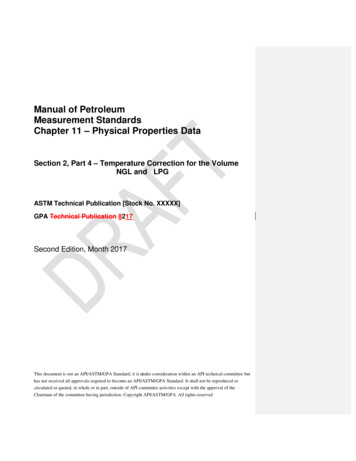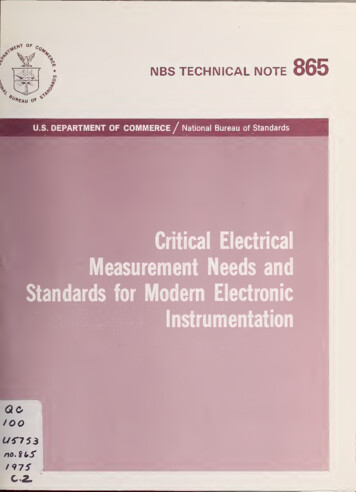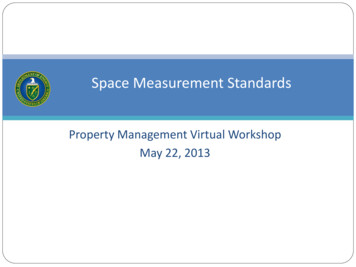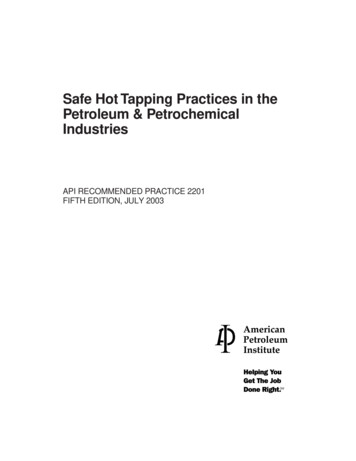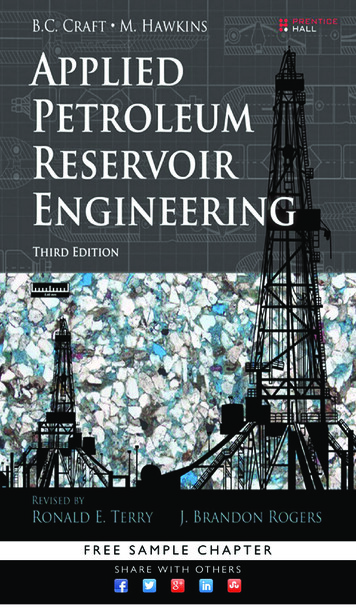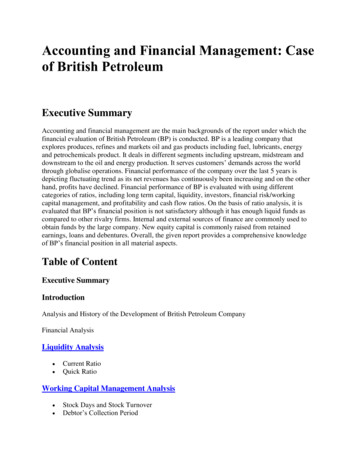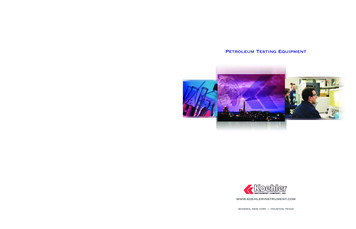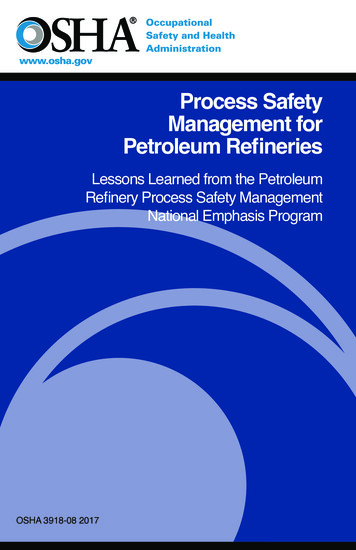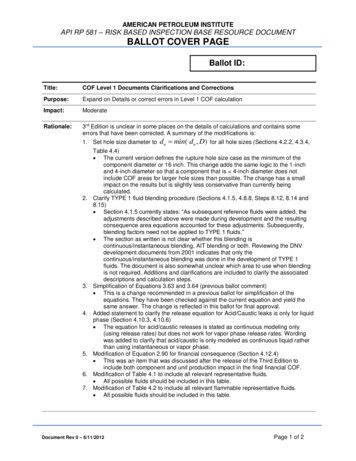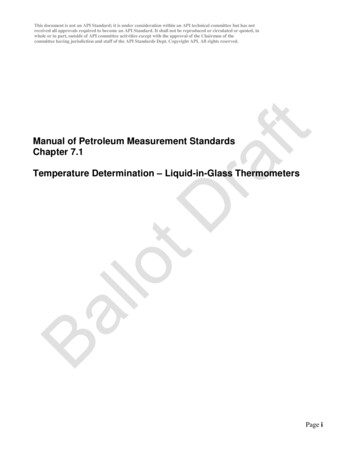
Transcription
This document is not an API Standard; it is under consideration within an API technical committee but has notreceived all approvals required to become an API Standard. It shall not be reproduced or circulated or quoted, inwhole or in part, outside of API committee activities except with the approval of the Chairman of thecommittee having jurisdiction and staff of the API Standards Dept. Copyright API. All rights reserved.Manual of Petroleum Measurement StandardsChapter 7.1Temperature Determination – Liquid-in-Glass ThermometersPage i
This document is not an API Standard; it is under consideration within an API technical committee but has notreceived all approvals required to become an API Standard. It shall not be reproduced or circulated or quoted, inwhole or in part, outside of API committee activities except with the approval of the Chairman of thecommittee having jurisdiction and staff of the API Standards Dept. Copyright API. All rights reserved.INTRODUCTION. .11SCOPE . 12NORMATIVE REFERENCES . 13TERMS AND DEFINITIONS . 33.1degree . 33.1.1 degree Celsius ( C). 33.1.2 degree centigrade . 33.1.3 degree Fahrenheit ( F). 33.2discrimination . 33.3thermometer. 33.3.1 liquid-in-glass thermometer (LIGT) . 43.3.2 low-hazard liquid . 43.3.3 mercury-in-glass thermometer (MIGT) . 43.3.4 partial immersion thermometer . 43.3.5 total immersion thermometer . 44GENERAL PRECAUTIONS . 44.1Safety. 44.1.1 Mercury Warning. 55UNITS OF MEASURE . 56EQUIPMENT AND DESIGN REQUIREMENTS. 56.1Liquid-in-Glass Thermometers . 56.1.1 General Information . 56.2Liquid-in-Glass Thermometer Assemblies . 86.2.1 Cup-Case Assembly . 86.2.2 Armored Case Assembly . 96.2.3 Angle-Stem Assembly. 106.3Thermowells. 116.3.1 Test Thermowells . 116.3.2 Sensor Thermowells . 116.3.3 Selection of Thermowell . 116.3.4 Pressure Rating . 116.3.5 Installation . 126.3.6 Material . 126.3.7 Thermal Conductivity . 127PROCEDURES FOR TEMPERATURE DETERMINATION. 127.1Static Temperature Determination Using Liquid-in-Glass Thermometers 127.1.1 General Information . 127.1.2 Procedures for Static Temperature Determination in Non or Low PressureTanks and Cargo Carriers . 167.1.3 Procedures for Static Temperature Determination in Pressure Storage Tanksand Cargo Carriers . 207.2Dynamic Temperature Determination Using Liquid-in-Glass Thermometers227.2.1 General Information . 227.2.2 Temperature Discrimination . 227.2.3 Dynamic Temperature Determination . 23Page ii
This document is not an API Standard; it is under consideration within an API technical committee but has notreceived all approvals required to become an API Standard. It shall not be reproduced or circulated or quoted, inwhole or in part, outside of API committee activities except with the approval of the Chairman of thecommittee having jurisdiction and staff of the API Standards Dept. Copyright API. All rights TION, VERIFICATION, AND CALIBRATION REQUIREMENTS 23Inspection. 23General . 23New and Recalibrated Thermometers . 23Cleaning . 23Verification . 24Tolerances . 24Single-point Verification . 24Multipoint Verification . 24Prior-to-use Verification . 24Periodic Verification . 25Ice-point Bath Preparation . 25Calibration . 25General . 25Mercury-in-Glass Tank Thermometers . 26Low-hazard Liquid-in-Glass Tank Thermometers . 26Reference Thermometers . 26Calibration Documentation or Certificates . 26Calibration Correction Factors . 27ANNEXESAnnex A (Informative) Mercury-in-Glass Thermometer Alternative Testing Phase I- Tank Measurement . 28Annex B (Normative) Emergent-Stem Correction for Liquid-in-Glass Thermometers. 30Annex C (Informative) Test Procedure for Determining Immersion Times of Liquid-inGlass Thermometers and their Assemblies . 37Annex D Local Direct-Reading Thermometers . 40FIGURESFigure 1 Types of Glass Thermometers and Their Use .6Figure 2 Typical Cup-Case Assembly .9Figure 3 Typical Armored-Stem Assembly 10Figure 4 Typical Angle-Stem Thermometer .11Figure B-1 Thermometers Immersed in Bath .30Figure B-2 Total Immersion Thermometer Partially Immersed in a Thermowell .31Figure B-3 Clip to Suspend Ambient Temperature Thermometer .32Figure B-4 Measuring Temperature of Emergent Liquid Column .32Figure B-5 Measuring Between Immersion Ring and Start of TemperatureScale (34 mm) .34Figure B-6 Determining How Many Degrees on the Thermometer Scale Correspondsto 34 mm (7 degrees) .34Page iii
This document is not an API Standard; it is under consideration within an API technical committee but has notreceived all approvals required to become an API Standard. It shall not be reproduced or circulated or quoted, inwhole or in part, outside of API committee activities except with the approval of the Chairman of thecommittee having jurisdiction and staff of the API Standards Dept. Copyright API. All rights reserved.TABLESTable 1 Maximum Deviation Limits: Operating Thermometer Versus ReferenceThermometer . .6Table 2 Tank Thermometers . .7Table 3 Dynamic Temperature Thermometers . .8Table 4 Minimum Number of Temperature Measurements for Various Depths ofHydrocarbon Liquid in Storage, Lease, Ship and Barge Tanks .13Table 5 Recommended Immersion Times for Woodback Cup-Case Assemblies .15Table 6 Thermometer Assemblies and Temperature Levels for Tanks and CargoCarriers 19Table 7 Temperature Measurements for Horizontal Cylindrical Tanks 20Table C-1 Suggested Bath Temperature .38Table C-2 Time Intervals for Reading Thermometers .38Table D-1 Tank Appurtenances for Temperature Measurement .40Page iv
Manual of Petroleum Measurement StandardsAPI MPMS Chapter 7.1 — Liquid-in-Glass ThermometersINTRODUCTIONThis section describes how to correctly use various types of liquid-in-glass thermometers toaccurately determine the temperatures of hydrocarbon liquids under both static and dynamicconditions. However for specifics on using liquid-in-glass thermometers for dynamicmeasurement see API MPMS Ch. 7.4.These temperatures are used to convert hydrocarbonliquid volumes to base conditions. Other methods, equipment, and procedures fortemperature determination are described in the other sub-sections of API MPMS Ch. 7. Themethod and equipment selection for temperature determination are left to the discretion of theparties involved.1SCOPEThis chapter describes the methods, equipment, and procedures for manually determining thetemperature of liquid petroleum and petroleum products under both static and dynamicconditions with liquid-in-glass thermometers. This chapter discusses temperaturemeasurement requirements in general for custody transfer, inventory control, and marinemeasurements. The actual method and equipment selected for temperature determination areleft to the agreement of the parties involved.The manual method covers: Non-pressurized tanks and non-pressurized marine vessels Gas-blanketed tanks and gas-blanketed marine vesselsIt does not cover hydrocarbons under pressures in excess of 21 kPa (3 psi gauge) orcryogenic temperature measurement, unless equipped with a thermowell.The requirements of this chapter are based on practices for crude oils and petroleumproducts covered by API MPMS Ch. 11.1 (ASTM D1250). Requirements in this chapter maybe used for other fluids and other applications. However, other applications may requiredifferent performance and installation specifications.2NORMATIVE REFERENCESAPIManual of Petroleum Measurement StandardsChapter 1, VocabularyChapter 2, (all sections) Calibration of Upright Cylindrical TanksChapter 3, (all sections) Tank GaugingPage 1
Chapter 8.1,Standard Practice for Manual Sampling of Petroleum and PetroleumProductsChapter 11.1, Physical Properties Data, Temperature and Pressure Volume CorrectionFactors for Generalized Crude Oils, Refined Products, and Lubricating OilsChapter 12.1.1, Calculation of Static Petroleum Quantities – Upright Cylindrical Tanksand Marine VesselsChapter 12.2, Calculation of Petroleum Quantities Using Dynamic Methods andVolumetric Correction FactorsChapter 15, Guidelines for Use of the International System of Units (SI) in the Petroleumand Allied IndustriesChapter 18.1, Custody Transfer – Measurement Procedure for Crude Oil gathered FromLease Tanks by TruckRP 500, Recommended Practice for Classifications of Locations for Electrical Installations atPetroleum Facilities Classified as Class I, Division 1 and Division 2RP 2003, Protection Against Ignitions Arising Out of Static, Lightning, and Stray CurrentsRP 3000, Classifying and Loading of Crude Oil into Rail Tank CarsASTM 1D1250, Standard Guide for Use of the Petroleum Measurement TablesE1, Standard Specification for ASTM Liquid-in-Glass ThermometersE77, Standard Test Method for Inspection and Verification of ThermometersE344, Terminology Relating to Thermometry and HydrometryE2251, Standard Specification for Liquid-in-Glass ASTM Thermometers with Low-HazardPrecision Liquids2OCIMFInternational Safety Guide for Oil Tankers and Terminals (ISGOTT)IMO 3Safety of Life at Sea (SOLAS)NIST4NIST Special
Refer to API RP 500 and NFPA 70 for guidance. When loading liquids that can accumulate static charges, refer to the precautions described in the International Safety Guide for Oil Tankers and Terminals, Safety of Life at Sea, API MPMS Ch. 3, and API RP 2003. Care must be taken with all liquid-in-glass thermometers to prevent breakage, which will result in a safety hazard. If the liquid in the .File Size: 656KBPage Count: 45
